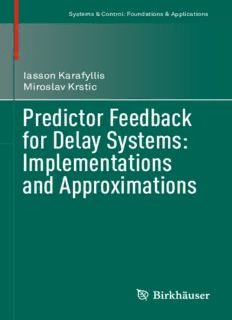
Predictor Feedback for Delay Systems: Implementations and Approximations PDF
Preview Predictor Feedback for Delay Systems: Implementations and Approximations
Systems & Control: Foundations & Applications Iasson Karafyllis Miroslav Krstic Predictor Feedback for Delay Systems: Implementations and Approximations Systems & Control: Foundations & Applications SeriesEditor TamerBas¸ar,UniversityofIllinoisatUrbana-Champaign,Urbana,IL,USA EditorialBoard KarlJohanÅstr€om,LundUniversityofTechnology,Lund,Sweden Han-FuChen,AcademiaSinica,Beijing,China BillHelton,UniversityofCalifornia,SanDiego,CA,USA AlbertoIsidori,SapienzaUniversityofRome,Rome,Italy MiroslavKrstic,UniversityofCalifornia,SanDiego,CA,USA H.VincentPoor,PrincetonUniversity,Princeton,NJ,USA MeteSoner,ETHZürich,Zürich,Switzerland; SwissFinanceInstitute,Zürich,Switzerland RobertoTempo,CNR-IEIIT,PolitecnicodiTorino,Italy Moreinformationaboutthisseriesathttp://www.springer.com/series/4895 Iasson Karafyllis (cid:129) Miroslav Krstic Predictor Feedback for Delay Systems: Implementations and Approximations IassonKarafyllis MiroslavKrstic DepartmentofMathematics Mechanical&AerospaceEngineering NationalTechnicalUniversityofAthens UniversityofCalifornia,SanDiego Athens,Greece LaJolla,CA,USA ISSN2324-9749 ISSN2324-9757 (electronic) Systems&Control:Foundations&Applications ISBN978-3-319-42377-7 ISBN978-3-319-42378-4 (eBook) DOI10.1007/978-3-319-42378-4 LibraryofCongressControlNumber:2016949408 MathematicsSubjectClassification(2010):93B52,93C23,93D15,93C10 ©SpringerInternationalPublishingAG,CH2017 Thisworkissubjecttocopyright.AllrightsarereservedbythePublisher,whetherthewholeorpartof the material is concerned, specifically the rights of translation, reprinting, reuse of illustrations, recitation, broadcasting, reproduction on microfilms or in any other physical way, and transmission or information storage and retrieval, electronic adaptation, computer software, or by similar or dissimilarmethodologynowknownorhereafterdeveloped. The use of general descriptive names, registered names, trademarks, service marks, etc. in this publicationdoesnotimply,evenintheabsenceofaspecificstatement,thatsuchnamesareexempt fromtherelevantprotectivelawsandregulationsandthereforefreeforgeneraluse. Thepublisher,theauthorsandtheeditorsaresafetoassumethattheadviceandinformationinthis book are believed to be true and accurate at the date of publication. Neither the publisher nor the authors or the editors give a warranty, express or implied, with respect to the material contained hereinorforanyerrorsoromissionsthatmayhavebeenmade. Printedonacid-freepaper ThisbookispublishedunderthetradenameBirkha¨user TheregisteredcompanyisSpringerInternationalPublishingAG,CH TheregisteredcompanyaddressisGewerbestrasse11,6330Cham,Switzerland Preface Time delays abound in dynamical systems. And long values of such delays often induce instability. The idea of using “predictors” of the future state or output, initiatedwiththe“Smithpredictor”inthelate1950sforcompensatinglongdelays inactuation,sensing,computation,orcommunication,preventssuchinstabilities— forlinearsystems.NexttothePIDcontrol,theSmithpredictorisarguablythemost frequentlyusedfeedbackstrategy. AbouthalfacenturyaftertheSmithpredictor—inthelate2000s—thepredictor idea was extended to nonlinear systems. In principle, any stabilizable nonlinear systemcanbestabilizedinthepresenceofanarbitrarilylonginputdelay. The reason why it took half a century to make the advance from linear to nonlinear systems has largely to do with the distinctions between the solvability of linear and nonlinear systems. Predictors employ model-based solutions of differential equations to produce a value of the future state, which the feedback law employs to compensate the delay. Model-based and explicit solutions are available for all linear systems. Nonlinear systems, in turn, are generically unsolvableinclosedform. Thenonlinearpredictorresultsofthelate2000s,usheredinbythesecondauthor of this book, do not tackle the question of solvability of nonlinear systems. They only employ the properties of such solutions, without presenting ways in which thosesolutionswouldbegeneratedinrealtime,toprovestabilization. This book bridges the chasm between the nonlinear predictor as a concept and thenonlinearpredictorasapracticaltool. Since nonlinear predictors are not solutions of nonlinear differential equations thathavetobeperformedjustonce—off-line—buthavetobeperformedcontinu- ously, in real time, developing methods to generate nonlinear predictors is not merelyaboutsolvingdifferentialequationsbutaboutensuringstabilitybyapplying feedbackgeneratedbyimperfectsolutionstodifferentialequationsinrealtime. This book supplies several methods for generating such solutions. We refer to them as approximate predictors. The solution methods we offer are diverse and v vi Preface include both numerical methods and methods that employ iterative analytical integrations. Sincethisbookdealswithbringingthenonlinearpredictormethodologycloser to reality, we address, in addition to delays on the input and output, a number of other“reality-induced”inconveniences: (cid:129) partialstatemeasurement, (cid:129) sampledmeasurement, (cid:129) uncertaintyinthesamplingschedule, (cid:129) inputapplicationviaZeroOrderHold, (cid:129) thepresenceofmeasurementnoiseandmodelingerrors. What Does the Book Cover? Thebookcoversallaspectsofthesolutionofrobust,globalstabilizationproblems bymeansofpredictorfeedbackforsystemswithconstantdelays. Thebookisdividedintothreeparts.PartIofthebookisdevotedtoLinearTime- Invariant (LTI) systems. The reason for the study of the application of predictor feedbacktoLTIsystemsinabookthatismostly“nonlinear”ismainlypedagogical. Allconceptsandnoveltiesintroducedinthebookareclearlyshowninthecontext ofLTIsystems,andthereaderistaughtthefollowingnotionswithoutthetechnical difficultiesthatarepresentfornonlinearsystems: (cid:129) theconceptofanapproximatepredictor (cid:129) closed-looprobustnesstomeasurementnoiseandmodelingerrorsunderpredic- torfeedback. Chapter 2 deals with predictor feedback for LTI systems with state measure- ment. The reader is introduced to three ways of implementing the predictor feedback: 1) thedirectimplementation, 2) thedynamicimplementation,and 3) thehybridimplementation. Alladvantagesanddisadvantagesofeachwayofimplementationarediscussed, anditisemphasizedthateach wayofimplementingpredictorfeedback leads toa differentkindofclosed-loopsystem: a) the direct implementation leads to a system described by Integral Delay Equa- tions(IDEs), b) the dynamic implementation leads to a standard time-delayed system with distributedstatedelays,and c) thehybridimplementationleadstoacomplicatedhybridsystemwithdelays. Preface vii Chapter 2 shows the robustness properties of each implementation but also emphasizes the fact that there are severe disturbance attenuation limitations due todelays.Morespecifically,novelresultsareprovidedforthespecificationofthe disturbanceattenuationlimitationforeverylinearandnonlinearsystemunderany kind of controller. Chapter 2 discusses the robustness of predictor feedback with respect todelayperturbations,andsimple(butconservative) explicitformulas are provided. Finally, Chapter 2 discusses the concept of the approximate predictor (i.e.,amappingthatapproximatesthefuturevalueofthestatevector)anditsusein predictorfeedback. Chapter 3 is dedicated to the predictor feedback for LTI systems with partial state measurement. The reader is introduced to the Inter-Sample Predictor- Observer-Predictor-Delay Free Controller (ISP-O-P-DFC) control scheme in the contextofLTIsystems.Indeed,whendelayedoutputmeasurementisavailable,we can no longer use the (approximate) predictor mapping directly. First, we have to use an observer (and an inter-sample predictor if the measurement is sampled) in order to obtain a continuous estimation of the past value of the state vector. Only then we are in a position to use the (approximate) predictor mapping, which can provideusanestimationofthefuturevalueofthestate. Part II of the book is devoted to nonlinear time-invariant systems. All notions introducedinapedagogicalwayforLTIsystemsarenowusedinfullextent.The use of approximate predictors is almost always necessary because the predictor mapping is available explicitly only for limited classes of nonlinear systems. Chapters 4 and 5 show that predictor feedback can be applied successfully with approximatepredictorstowideclassesofnonlinearsystems. Part III of the book is devoted to extensions of predictor feedback either in a conceptual level or to different classes of systems. The conceptual extension of predictorfeedbackleadsustothenotionofasystemdescribedbyIDEs,whichare analyzedindetailinChapter7.Theextensionofpredictorfeedbacktootherclasses of systems leads us to the application of predictor feedback methodologies to discrete-timesystems:thisisthetopicofChapter8. Who Is the Book for? This book should be of interest to researchers working on control of time-delay systems.Manyengineers,mathematicians,andstudentsareworkingonimportant control-theoretic aspects of time-delay systems, and a significant number of them havebecomeusersofpredictorfeedbackmethodologies.APh.D.studentcanfind thecurrentstateoftheartinpredictorfeedbackdesigninthisbook. Time-Delaysystemsareabundantinmanysciences:physics,biology,engineer- ing and economics. Stabilization problems arise naturally in many cases, and the implementation of globally stabilizing predictor feedback laws can solve such problemselegantlyandrobustly. viii Preface MathematiciansmayalsobeinterestedinthematerialofChapter7onIDEs.It has been shown that IDEs are closely related to systems described by first-order hyperbolic partial differential equations arising in mathematical physics, mathe- maticalbiology,andengineering. The book starts from the already fairly advanced state of the art in stability theory and feedback design for nonlinear ordinary differential equations. We assume that the reader is familiar with stability and feedback stabilization theory foruncertainnonlinearfinite-dimensionalsystemsatleastatamoderatelyadvanced level.Themathematicalbackgroundneededforthecompletecomprehensionofthe resultsinthepresentbookisprovidedinChapter1,wheremanyusefulnotionsin nonlinear mathematical control theory are reviewed for the reader’s convenience. The reader who is not familiar with these notions can return to Chapter 1 when needed. Athens,Greece IassonKarafyllis LaJolla,CA,USA MiroslavKrstic September14,2015 Acknowledgments MiroslavKrsticthanksNikosBekiaris-Liberis,DelphineBresch-Pietri,andMrdjan Jankovicfortheircollaborationandinspirationintheareaofdelaysystems,aswell as the following collaborators on related topics in control of hyperbolic PDEs: RafaelVazquez,Jean-MichelCoron,AndreySmyshlyaev,FlorentDiMeglio,and Federico Bribiesca Argomedo. Miroslav also warmly thanks his daughters Alexandra and Victoria and his wife Angela for the joint daily experiences in delaycompensationandpunctuality. IassonKarafylliswouldliketothankallthepeoplewhounderstoodwhathehas beenthroughthelastfiveyearsofhislifeanddedicatesthisbooktothreewomen who have tortured himina very sweet and lovingway:Xριστίνα, Kατερίνα, and Oλυμπία. ix
Description: